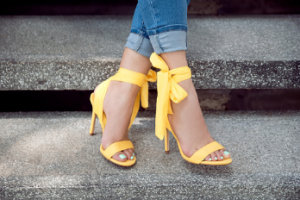High heels are a type of shoe with a raised heel. They are designed to make the wearer’s heel higher than their toes and are often made of high-quality materials. This article will discuss the history of high heels, the design trends, and their impact on the feet. Once you understand high heels, you can choose the perfect pair for any occasion. This article also explains how to care for your high heels and what you should avoid wearing them when possible.
Historical significance
 The aristocracy of the sixteenth century recognised the impracticality of women’s flat shoes and began wearing high heels to mimic their royal counterparts. However, there were rules about heel height in their society, and the aristocracy only wore heels up to two inches high. The rise of courtesans led to commoners also wearing high heels. During this time, women of the court wore heels for the same reasons men wore flat shoes: to appear intimidating.
The aristocracy of the sixteenth century recognised the impracticality of women’s flat shoes and began wearing high heels to mimic their royal counterparts. However, there were rules about heel height in their society, and the aristocracy only wore heels up to two inches high. The rise of courtesans led to commoners also wearing high heels. During this time, women of the court wore heels for the same reasons men wore flat shoes: to appear intimidating.
The invention of the high heel began in Europe. The French Revolution impeded mass production of heels, which became a sign of aristocratic class and social status. In the 16th century, the European aristocracy began wearing heels in Paris. After World War II, emerging designers began using a thin metal rod to support the heel, called a stiletto. This new style changed the face of women’s fashion and became associated with bare legs and a woman’s aggressive sexuality.
Design trends
There are several design trends to consider for the upcoming season. Several designers follow the same basic formula but incorporate different styles and materials. For example, designers such as Nina Ricci, Dries Van Noten, and Jacquemus are creating high heels that are both practical and fashionable. In addition, some designers have switched out laces for tie details, and others are reinterpreting classic styles. For example, check out the styles of Spendless Australia high heels.
Despite their enduring appeal, black stilettos are a must-have for the upcoming fall season. The black stilettos have become a must-have from Valentino to Prada this season. Even kids have become fashion conscious, and many world-renowned brands have introduced unique high heels for children. So you’ll be sure to find the perfect pair in this season’s hottest colour, too!
Manufacturing methods
There are various manufacturing methods for high heels. High heels are made up of three different sections – the sole, upper, and heel. These parts are manufactured separately and are then joined together. The sole and upper are manufactured using computer-controlled machines that ensure the highest quality and comfort. Unlike leather shoes, which are often made by hand, high heels are usually not moulded or moulded by machines. Instead, they are designed to be as light as possible and to resist breaking under the weight of a human being.
The first step in manufacturing high heels is called die cutting. Next, a machine is used to cut leather pieces or other materials. The pieces are then sewn, cemented, or pressed together. After the parts are stitched together, the heel is stitched, glued, or nailed to the shoe. The last is used to help in fitting the pieces together. Manufacturing methods for high heels are as diverse as the shoe industry.
Impact on the foot
High heels place more pressure on the feet and ankle than flats and sneakers. This can result in numerous foot problems, including stress fractures, neuromas, and hammertoe. The foot arch can also be strained, making walking or standing painful. If you’re wearing high heels all day long, you should consider how much you wear them each day. Here are some ways to minimise the negative impact on your foot and ankle. Check out the styles of Spendless Australia high heels.
Wearing high heels can also cause ligament damage to the anterior talofibular ligament, which stabilises the ankle joint. Damage to the ligament can lead to ankle instability, requiring a brace, physical therapy, or even surgery. To prevent this from happening, choose a heel that is moderate in height and wide enough for your foot to accommodate the toes without causing pain. Unfortunately, it can also cause flat feet and tight calves.
